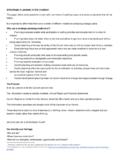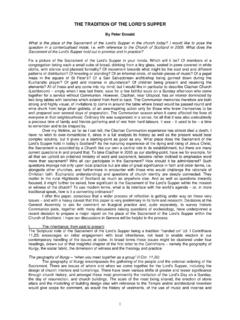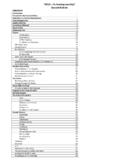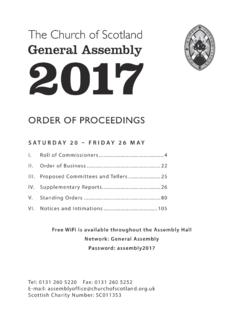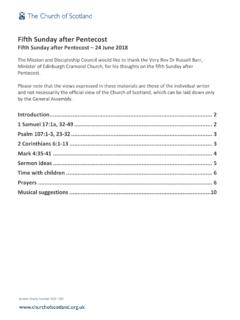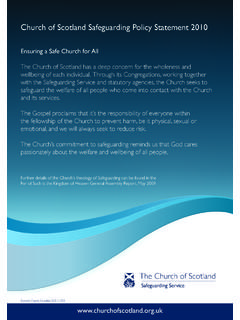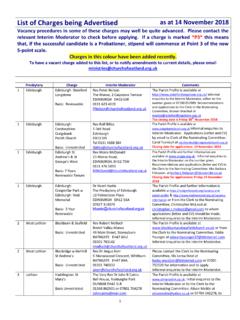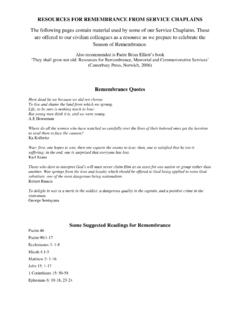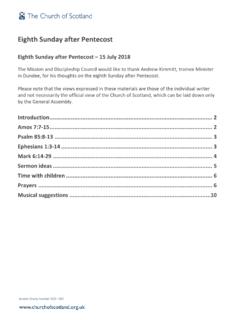Transcription of PROPERTY REGISTER OF CONGREGATION IN ... - …
1 Page 1 of 25 PROPERTY REGISTER OF .. CONGREGATION IN THE PRESBYTERY OF .. This REGISTER refers to all buildings other than manses. A Manse Condition Schedule should be completed in respect of the manse. This document can also be found in the General Trustees Building and PROPERTY Resources section of the website. THE church OF SCOTLAND GENERAL TRUSTEES 121 GEORGE STREET EDINBURGH EH2 4YR TELEPHONE 0131 225 5722 Revised March 2013 Page 2 of 25 INDEX Page SECTION 1 Introduction .. 3 Summary of Duties of Financial Board .. 4 Deed of Constitution .. 4 Regulations regarding Works at Ecclesiastical Buildings .. 4-5 Act Anent Care of Ecclesiastical Properties .. 6 Procedure to be followed when Repairing or Altering Buildings .. 7 SECTION 2 Schedule of Properties .. 9 Inventory of Furnishings and Equipment .. 10-12 SECTION 3 Schedule of Insurances .. 13 SECTION 4 Annual Inspection Records of the subjects.
2 14-22 Disability Discrimination Act .. 23 Asbestos REGISTER .. 23 Fire Risk Assessment for church Buildings .. 23 Working at Heights Regulations .. 23 SECTION 5 List of Authorised Works .. 24 SECTION 6 Quinquennial Inspection by Presbytery .. 25 Page 3 of 25 INTRODUCTION SECTION 1 General This PROPERTY REGISTER is issued by the church of Scotland General Trustees and is required to be kept by all congregations by the Act of the General Assembly anent Care of Ecclesiastical Properties. A single REGISTER will be retained where the church and any Halls are essentially one structure. Where the Halls are stand-alone buildings, not physically attached to the church , then a separate PROPERTY REGISTER will be retained for the Halls on the one hand and the church on the other. In relation to the Manse, a Manse Condition Schedule should be completed and returned annually to Presbytery. IT IS ANTICIPATED THAT, AFTER THE INITIAL RETURN UTILISING THE NEW PROPERTY REGISTER FORMAT, ONLY SECTIONS 3 (INSURANCE OF PROPERTIES) AND 4 (RECORD OF ANNUAL INSPECTION OF FABRIC INTERNALLY AND EXTERNALLY) WILL BE REQUIRED TO BE COMPLETED AND PRESENTED AT PRESBYTERY ANNUALLY.
3 EXCEPTIONS WILL BE WHERE THERE ARE CHANGES TO THE SCHEDULE OF PROPERTIES AND ADDITIONS/DELETIONS TO THE INVENTORY OF FURNISHINGS AND EQUIPMENT. PLEASE NOTE HOWEVER THAT AMENDMENTS FROM YEAR TO YEAR MAY BE REQUIRED TO THE church /HALL RISK ASSESSMENT SHEET. Congregations are responsible for the maintenance and insurance of buildings regardless of whether their titles are in the names of the General Trustees or in the name of local trustees for the CONGREGATION . Congregational constitutions place these duties on the body referred to in this REGISTER as the Financial Board . The Financial Board is the Congregational Board for congregations within the 1989 Deed of Constitution (the Model Constitution); the Deacons Court for congregations with the former United Free church Constitution; The Committee of Management for congregations within the Former United Presbyterian church Constitution; and the Kirk Session for congregations with the Quoad Omnia Constitution.
4 Schedule of Properties, Inventory of Furnishings and Equipment Annual Inspection & Retention of Previous Annual Inspections The purpose of this section of the REGISTER is to retain a basic record of the building and essentially of its contents. This section only needs to be completed at the commencement of this REGISTER and only altered thereafter if there is a change in either the subjects or the contents. Annual Inspection This REGISTER is intended to be an aid to good PROPERTY maintenance. Its loose leaf format enables the annual inspection report to be recorded along with the previous year s report in order to maintain a record of maintenance works carried out on the fabric over several years. The REGISTER is to be exhibited at the Presbytery Annual Inspection of Records. In relation to the Manse, the Manse Condition Schedule should be completed and returned to Presbytery annually.
5 Letting it Happen Booklet This handbook provides excellent guidance on various issues covering buildings maintenance, energy management, access for the disabled etc. It is available online in the General Trustees Building and PROPERTY Resources section of the church of Scotland website or by post from the church of Scotland General Trustees Department. Page 4 of 25 Summary of Duties of Financial Board SECTION 1 The object of this section is to provide a simplified statement of the duties falling on the Financial Board of a CONGREGATION under church of Scotland PROPERTY legislation. It makes no claim to be comprehensive and reference should be made to Appendix 1 for the exact wording of the relevant Regulations and Act Deed of Constitution Article Tenth of the 1989 Model Deed of Constitution provides that the Financial Board must maintain and fully insure the fabric of all heritable properties.
6 It also states that no ordinary repairs, improvements or material additions should be carried out until sufficient funds have been raised or assured for the purpose. The obligations of a Financial Board operating under one of the other forms of constitution are similar but the duty to maintain the fabric of all properties is subject to the Board complying with the Regulations summarised in the immediately following section. Regulations regarding Work at Ecclesiastical Buildings SECTION 1 It is necessary to distinguish between REPAIRS and ALTERATIONS. REPAIRS are operations to make good faults and failures and include redecoration in former colours with no change in appearance. Repairs therefore include most of the ordinary ongoing everyday work at buildings. In terms of the Regulations, repairs require the approval of Presbytery but:- (a) Presbytery has power to dispense with the need for its approval and most Presbyteries have set a cost figure up to which the Financial Board can proceed with repair work without obtaining the approval of Presbytery.
7 (b) If the total cost of the repair work (including any fees and VAT) exceeds the Financial Limit laid down by the General Assembly ( 50,000 as at 2011), Presbytery cannot give unconditional approval without first referring the matter to the General Trustees. (c) Repairs which are urgently necessary in the interests of safety or health or for the preservation of the building may be carried out without consent subject to immediate intimation to Presbytery being given. ALTERATIONS are defined as operations involving any change at the building and the term includes demolition or partial demolition, erection, extension, reconstruction, restoration and redecoration unless these involve no change in character or appearance. Page 5 of 25 In terms of the Regulations, alterations require the approval of both Presbytery and the General Trustees but:- (a) Both bodies have power to dispense with the need for their consents.
8 Different Presbyteries will have different rules in this regard and the circumstances in which the General Trustees approval is not required are set out at the end of the Regulations printed in Appendix 1. (b) As in the case of repairs, if the total cost of alterations (including any fees and VAT) exceeds the Financial Limit set by the General Assembly, Presbytery cannot give unconditional approval without first referring the matter to the General Trustees. (c) Again, as in the case of repairs, alteration work which is urgently necessary in the interests of safety or health or for the preservation of the building may be carried out without consent subject to immediate intimation to Presbytery and the General Trustees. The Consultative Committee on church Properties to which reference is made above is a body set up by the General Assembly of 1992 with a view to ensuring that large sums are not spent unadvisedly on buildings not necessary for the ongoing missionary strategy of the church .
9 If the cost of work exceeds the Financial Limit Presbytery should not approve unless it is satisfied that the building is necessary in this context or the work is necessary in the interests of safety or to preserve the value of the building as a marketable asset. If Presbytery does wish to approve of the work then it must refer the matter to the Consultative Committee. If this Committee concurs, then the approval of Presbytery can be taken to have been given. If the Consultative Committee does not concur, it will advise both Presbytery and the General Trustees of the areas of concern it has with regard to the proposed work. Presbytery must then give due consideration to the response of the Committee and reach a decision on the merits of the case. Approval from the General Trustees is quite separate from Presbytery approval but their power to give approval is also qualified in the case of alterations (including redecoration) at churches by the need to consult with the Committee on church Art and Architecture (CARTA) and if a Financial Board is contemplating carrying out alterations at a church it is strongly advised to consult with the Committee at the earliest possible stage.
10 Approval given under the Regulations lapses after three years unless acted upon. Note:- Loans and grants from the Central Fabric Fund can be made available for necessary works at ecclesiastical buildings. Applications for these or for the release of funds held by the General Trustees are in addition to the above approvals and it should be made clear when these are also being made. Page 6 of 25 Act anent Care of Ecclesiastical Properties SECTION 1 In terms of the Act the Financial Board must appoint a Fabric Committee, including, or with the help of, people with technical knowledge and experience in dealing with PROPERTY . This Committee should have a Convener and it is helpful if he maintains this REGISTER . The Fabric Committee is responsible for carrying out, at least once a year, an inspection of all ecclesiastical properties: the annual inspection. The Financial Board has to obtain and complete this PROPERTY REGISTER (Manse Condition Schedule for Manses).
